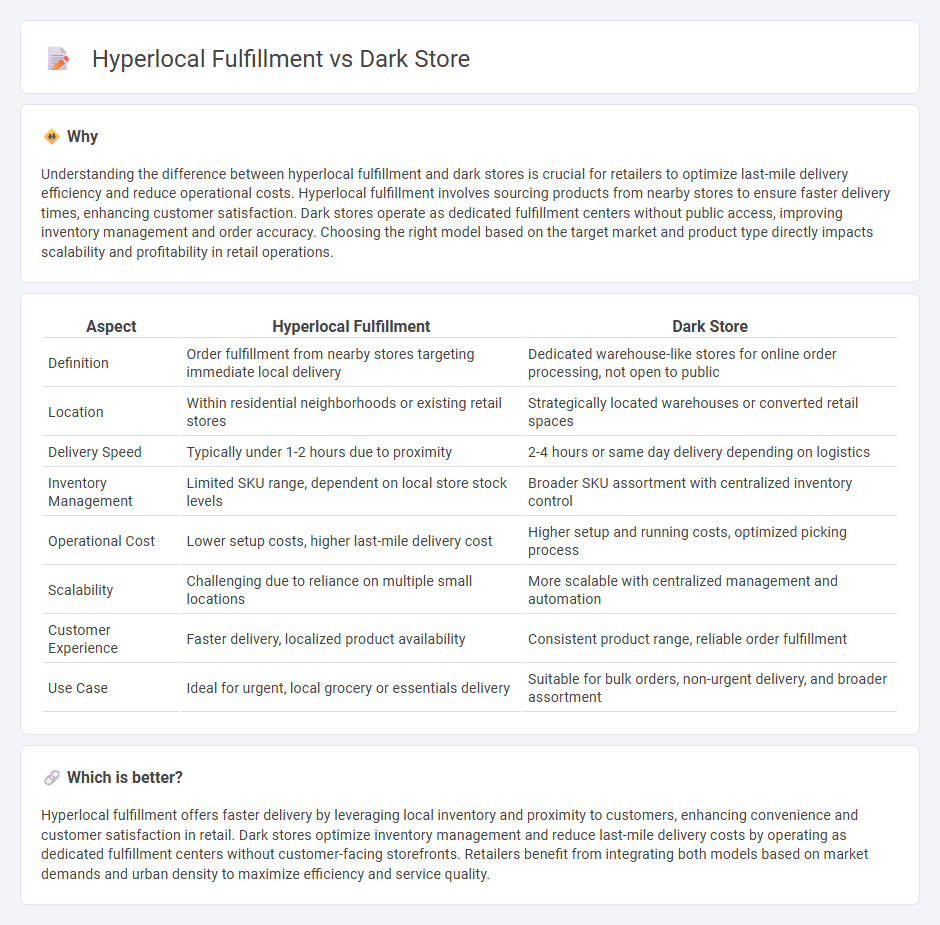
Hyperlocal fulfillment leverages nearby retail locations or local warehouses to deliver products rapidly within a limited geographic area, enhancing customer convenience and reducing delivery times. Dark stores, on the other hand, are specialized fulfillment centers not open to the public, designed exclusively for processing online orders efficiently at scale. Explore the distinct advantages and applications of hyperlocal fulfillment and dark stores to optimize retail supply chains.
Why it is important
Understanding the difference between hyperlocal fulfillment and dark stores is crucial for retailers to optimize last-mile delivery efficiency and reduce operational costs. Hyperlocal fulfillment involves sourcing products from nearby stores to ensure faster delivery times, enhancing customer satisfaction. Dark stores operate as dedicated fulfillment centers without public access, improving inventory management and order accuracy. Choosing the right model based on the target market and product type directly impacts scalability and profitability in retail operations.
Comparison Table
| Aspect | Hyperlocal Fulfillment | Dark Store |
|---|---|---|
| Definition | Order fulfillment from nearby stores targeting immediate local delivery | Dedicated warehouse-like stores for online order processing, not open to public |
| Location | Within residential neighborhoods or existing retail stores | Strategically located warehouses or converted retail spaces |
| Delivery Speed | Typically under 1-2 hours due to proximity | 2-4 hours or same day delivery depending on logistics |
| Inventory Management | Limited SKU range, dependent on local store stock levels | Broader SKU assortment with centralized inventory control |
| Operational Cost | Lower setup costs, higher last-mile delivery cost | Higher setup and running costs, optimized picking process |
| Scalability | Challenging due to reliance on multiple small locations | More scalable with centralized management and automation |
| Customer Experience | Faster delivery, localized product availability | Consistent product range, reliable order fulfillment |
| Use Case | Ideal for urgent, local grocery or essentials delivery | Suitable for bulk orders, non-urgent delivery, and broader assortment |
Which is better?
Hyperlocal fulfillment offers faster delivery by leveraging local inventory and proximity to customers, enhancing convenience and customer satisfaction in retail. Dark stores optimize inventory management and reduce last-mile delivery costs by operating as dedicated fulfillment centers without customer-facing storefronts. Retailers benefit from integrating both models based on market demands and urban density to maximize efficiency and service quality.
Connection
Hyperlocal fulfillment relies on dark stores as strategically located mini-warehouses within urban areas to enable rapid order processing and same-day delivery. Dark stores optimize inventory management and reduce last-mile delivery times by operating exclusively for e-commerce, separate from traditional retail environments. This synergy enhances customer satisfaction through quicker fulfillment and increased product availability in densely populated regions.
Key Terms
Centralized Warehousing
Dark stores operate as centralized warehouses designed exclusively for online order fulfillment, optimizing inventory management and reducing delivery times within targeted regions. Hyperlocal fulfillment leverages these centralized facilities to enable rapid, last-mile delivery by strategically positioning inventory close to demand hubs. Explore the advantages of centralized warehousing in enhancing hyperlocal fulfillment efficiency and customer satisfaction.
Last-Mile Delivery
Dark stores streamline last-mile delivery by operating as dedicated fulfillment centers optimized for rapid order processing and reduced delivery times. Hyperlocal fulfillment leverages nearby retail locations to provide ultra-fast delivery within limited geographic areas, enhancing customer convenience and real-time inventory accuracy. Explore the advantages and challenges of dark stores versus hyperlocal fulfillment to optimize your last-mile delivery strategy.
Inventory Proximity
Dark stores operate as dedicated fulfillment centers located near high-demand areas, optimizing inventory proximity to speed up delivery for online orders. Hyperlocal fulfillment leverages local retailers or small warehouses to maintain inventory close to the customer, enhancing same-day or instant delivery capabilities. Explore detailed strategies to maximize inventory proximity and improve fulfillment efficiency.
Source and External Links
Dark store - Wikipedia - A dark store is a retail outlet or distribution centre that exists exclusively for online shopping, usually acting as a large warehouse to facilitate online orders either for delivery or click-and-collect services, a concept that started in the UK and spread globally.
What is a Dark Store? How to Make it Work for You - A dark store is a former brick-and-mortar store closed to the public, repurposed as a fulfillment center for online orders enabling faster, more accurate order processing, delivery, or pickup, with usage growing notably during and after pandemic lockdowns.
What Is a Dark Store? - NetSuite - A dark store is a physical retail location turned into a fulfillment depot for online orders using home delivery, curbside, or pickup options, helping traditional retailers compete with e-commerce by leveraging their existing inventory and locations during shifts to online shopping.
 dowidth.com
dowidth.com